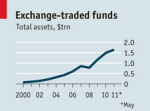
In Finance, the simple ideas are often the best. Exchange-traded funds, first launched 21 years ago, were a great idea. They were in effect tradable mutual funds. An investor got exposure to a diversified portfolio of shares, like the S&P 500 index, at low cost. And he could sell it easily, like any other equity.
But the popularity of such funds, which now have $1.5 trillion of assets under management, was too great a temptation. When the public took to plain-vanilla ETFs, the financial services industry decided it should also offer egg-custard and blue-banana flavours. Investors can choose between more than 2,700 funds covering everything from Asian property to water companies. They can also buy leveraged funds, which rise and fall more rapidly than the assets they track, and “inverse ETFs”, which move in the opposite direction.

